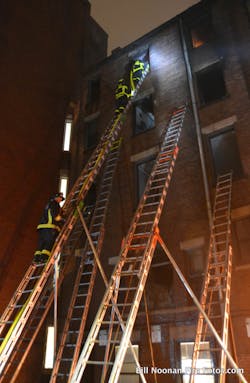Fornell: If You Got 'Em, Throw 'Em
Last June, the Boston Fire Department fought a multiple alarm fire in a congested area of the city with heavy fire on the upper floors of an occupied building. The rear of the 5-story building was inaccessible to apparatus, but upper floor access was urgently needed for search, rescue and ventilation.
For most of the fire departments in this country, the only tool that would help accomplish this task, a 50-foot extension ladder, would not have been available. Of course, being Boston, the necessary ladders went up in a hurry, almost as a matter of routine. The building construction and layout of Boston makes long ground ladders a necessity, but, as multi-story frame buildings, constructed on narrow streets in new communities, are rapidly becoming the norm across the country, justification for carrying ladders longer than minimum NFPA Standard 1901 recommendations, is growing.
I'm amazed to see departments spending over a million dollars on a piece of aerial apparatus that carries only one 35-foot extension ladder as its longest portable. If you are venting the roof of a large commercial building, doesn't good practice dictate you should have two means of egress? How can only one ladder of a required length accomplish that purpose?
While 24-foot, 28-foot and 35-foot ladders are certainly the workhorses for the majority of our fires, maybe a ride around your district with an open mind would convince the administration that yes, the new aerial needs more and longer ladders.
Of course, there will be those who say that they don't have the staffing to throw a ladder longer than 35', but that's just a convenient excuse for lack of realistic training. Imagine, looking at the first photo that accompanies this article, shouting to a lady hanging from the 5th floor window that, sorry, we didn't feel like specifying a longer, heavier ladder on the new rig because training with the thing would have been too strenuous.
I've always said if the equipment is available, it will be used when necessary. If someone is trapped on an upper floor and a ladder of the proper length is available, it will go up-- guaranteed.
With enormous frame McMansions being constructed in what previously were predominately rural areas, I find that I'm suggesting more and more, that carrying a 35' or longer ladder on a water tanker/tender might be a good idea. It can be set off on the scene when the tanker makes its initial drop. If not needed, no big deal. If it is needed, however, it can be put in service immediately.
Of course, while the need to carry longer ladders should be carefully evaluated, sometimes we overlook the obvious as well.
It is a safe bet to say that most pumper and ladder apparatus in this country carry a 10-foot folding ladder. While we've used it for years, it is actually about 12' long when folded and a bit hard to maneuver inside a cramped residence. How many of us have knocked over a lamp or broke a globe on a light fixture, or knocked a clock or picture off a wall while manhandling the thing? Guilty here on all three counts.
More and more departments are carrying combination ladders such as the Little Giant which can be used as a short 17-foot extension or step ladder. The newest model, introduced this year, called the Overhaul ladder, even has folding roof hooks.
Another simple solution is a narrow two-section 10-foot extension ladder commonly called a Fresno. Detroit is one department that uses that ladder at almost every fire.
Called a "Dutchtown" there, (historians tell me that an early manufacturer was the Dutchtown Ladder Company, and the name, fastened to their wooden rails, stuck as a nickname), the ladder is routinely brought to the front door of the fire building, usually by the junior member of the ladder company. The department faces a preponderance of burned out staircases (favorite spot for arsonists to start a fire) and most attics have no stairs for access, making the Dutchtown an ideal tool for their operations.
Only 5 feet long, it is easy to maneuver inside a tight apartment, and its heavy duty rails and rungs form a stable platform when bridging burned out staircases or operating a line into a blind attic.
So next time you are on your way to get fuel, or out pre-planning a new construction project, take some time to make a focused assessment and make sure that the ladders you have on the rig are going to get the job done when the chips are down.
